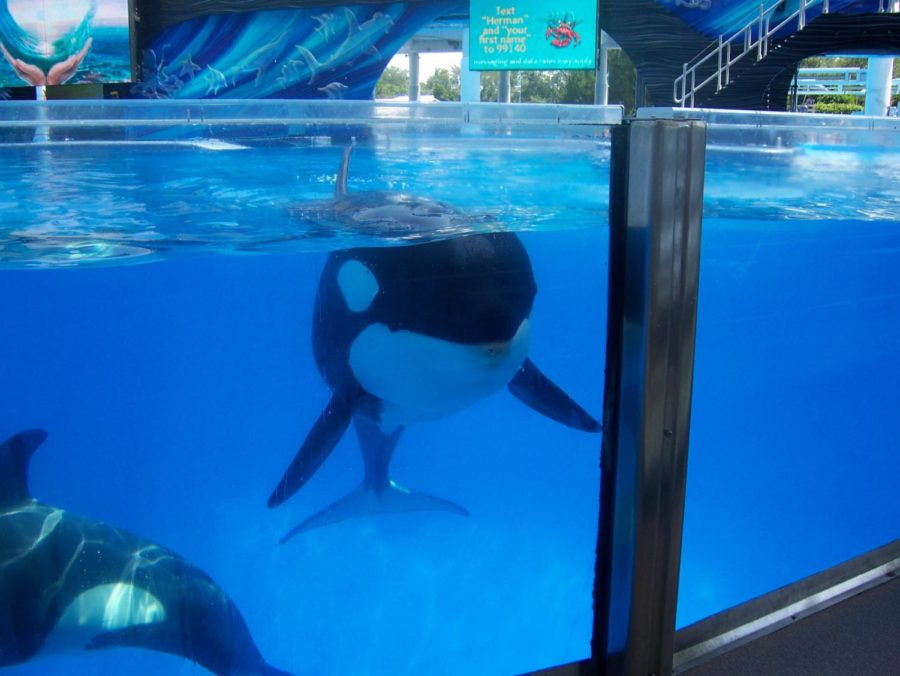Titus: Entertainment at a deadly cost
opinion: whales in captivity
January 17, 2014
SeaWorld is easily one of the coolest places I have ever visited. Watching a diver train and swim with a killer whale is a breathtaking experience. Wanting to learn more, I researched what it took to be able to train a killer whale — or any wild animal — and what I found was appalling. The hidden histories of the animals and the injuries that went unrecorded were bad, but the worst of it was learning the terrible things the whales have to go through in order to make people happy.
To become a killer whale trainer at SeaWorld you do not really need to have any sort of background with animals. People from all over the country can be trainers at SeaWorld with just a little more training than a lifeguard. Swimming and being underwater for an extensive amount of time are nearly the only prerequisites of becoming a trainer.
Jumping in the water with an animal that is large enough to swallow you whole would be intimidating enough, but add the fact that you don’t know the hidden background of the animal and jumping in the water suddenly becomes a life or death situation.
The movie “Blackfish” goes into detail about SeaWorld hiding information from their trainers in order to keep sales high. A popular case from the movie was the death of three different individuals by a male killer whale named Tilikum.
Tilikum was captured by whale hunters hired by SeaWorld near Iceland. In order to catch the whales near Iceland, the hunters must first separate the whale babies from their mothers. Because the mothers are so large, only the babies are taken into captivity.
Whales travel in pods and they stay in the same pod for their entire lives. When a baby whale is separated from its mother it reacts similarly to how a human child would react were it separated from its mother. Because whale families are so similar to ours, the detachment issues they acquire can even cause the mothers to attempt to beach themselves.
At SeaWorld the babies are separated from their mothers at a very young age and the mother will send out sound waves to try to contact the baby. If that does not work she may even separate herself from her pod. This goes to show that the “happy” killer whales that you are seeing at SeaWorld are really anything but happy.
Imagine how scared you would be if you were separated from your mother at such a young age. Whales are very smart; they have the brain capacity to register the loss of familiar whales. A mother can even mourn for her baby.
Lastly, SeaWorld, according to the movie “Blackfish,” use many fake facts to cover up the fact that keeping these great animals in captivity is really harmful to them. The average killer whale lives to be nearly 100 years old, while in captivity that age is closer to thirty or forty.
Tilikum’s dorsal fin has also become bent after his time in isolation. SeaWorld says that this is common among the orcas when in reality this only happens to roughly one percent of the killer whales in the wild, while it happens to nearly 99 percent of whales that live in captivity. It is safe to say that the orcas are definitely not benefitting from being in captivity.
Next time you are thinking about attending a SeaWorld performance think about the dangers those divers are putting themselves through to put on a good show, but also think about the danger and conditions that the killer whales are living though every day.
Whales can swim hundreds of miles a day, and although the tanks are big, there is nothing that can compare to the ocean water that the wild whales call home. Whales are not the only animals that are undeservingly being put on display, but because they are so similar to humans it is easy to see the relation.
After all, we would not take a child away from its mother and throw it in a cage for thousands of people to see. It would be considered child abuse. Why should the treatment of these magnificent creatures be considered anything other than the animal abuse that it really is?







